1.0 Background
Millions of girls in developing countries are still being denied an education. This issue is
worldwide and slow education progress for girls nowadays will have a huge impact in society
over lifetime. To resolve this issue, Q8 engineering teams are concerned the girls’ educational
issues, using internet source for boosting STEM education, and technologies that interface with
resolving girls’ education.
1.1 Girls Education issue and facts
There are still around 58 million of girls don’t have the opportunities of having education.
Statistics shows that one in four children suffers from health issues, which reduce their odds of a
decent education [1]. There are still 31 million girls are not attending primary schools. Of these
17 million are probably not attending schools for their whole life. Based on UNESCO, in Nigeria
there is around five and half million, Pakistan over three million, Ethiopia over one million are
out of school [2]. According to the 2011 Tanzania Education Sector Analysis, the 2009 Primary
School Leaving Examination (PSLE) pass rate for the region of Manyara, in which Lesoit
resides, is 56% vs. 70% for Dar es Salaam [3]. The PSLE scores in Table 1.1 show the pass rates
for the Math and Sciences subjects for 2009 [3]. The table below shows there is huge clear
gender disparity with females having lower scores than the males.
Table 1.1 PSLE Math and Sciences Pass Rate by Gender 2009
PSLE Math and Sciences Pass Rate by Gender
Gender Male Female
Math 25% 17%
Sciences 60% 47%
Girls’ education has a huge impact on all of societies around the world. Researchers have found
that educating girls can save millions of lives, improves child health, reduce the birth rate in
early ages, reduces the gap between men and women, higher chances in finding work, and much
more. In brazil, if women had secondary education that would increase the chance in getting a
job by 60%.
1.2 Internet and Education
The Internet is useful nowadays for society seeking for better knowledge, it has shifted the world
into a new phase. A phase of communication and online entertainment, educational purposes,
and much more [4]. Internet contain vital knowledge all around the world with one step to take,
which is exploring. Students have extra resources and information about certain subjects which
save girls from buying and holding heavy textbooks [4]. Internet can offer online classes that
being taught thousands of miles away. If girls in rural area don’t have access to school, she could
still get access to education by having classes through internet access. Communication between
the teacher and student would be easier with any condition. Improving communication between a
teacher and a student would give the opportunities to advantage for teachers to help girls away
from them.
1.3 Technologies Interface with Education
Wealthy regions can afford more and better teachers and have more resources like electricity,
internet, and computers [5]. Without bringing new technology to developing countries, these
trends will continue unaddressed. In order to use the internet, girls need to have a new
educational technology. Tablet is one of the best options girls could have in increase education
proficiency. A research study shows that kindergarteners students have better scores on literacy
when using tablets than those who don’t tablets [6]. According to Houghton Mifflin Harcourt in
California, stated that using tablets made students score 20% more in their math test [6]
2.0 Design Hardware Phase: Solar powered tablet using internet access
Raspberry pi micro-controller is a small credit card sized computer with various functions. Q8
engineering team designed a raspberry pi tablet powered through renewable energy source and
various connectors with its design to resolve the problem addressed above. In the flow chart
below, it shows the all hardware designs Q8 team considered in their tablet.
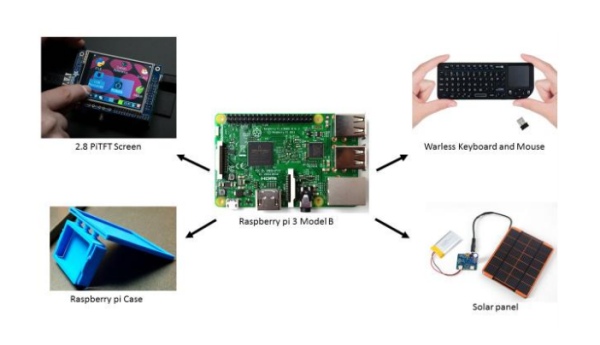
2.1 Raspberry Pi Components
The Raspberry Pi Micro-Controller is a small, credit card sized computer with a design based
upon the BCM2835 System on an S O C [7]. It contains 1 G bytes of RAM and has sockets for
boot media and persistent storage. The computer is sold as a bare, single motherboard unit
without power supply, housing, keyboard, mouse and screen [7]. Because of these factors, it is a
low cost base that lends itself to be built into a number of different fully functioning devices such
as tablets, GPS and GSM modules, image processors for ASV’s and medical devices, and many
others. Raspberry Pi has various connectors within its design such as RCA Video, Audio,
Ethernet, HDMI, DSI Display and USB to connect to different devices and operate of the
computer [7].
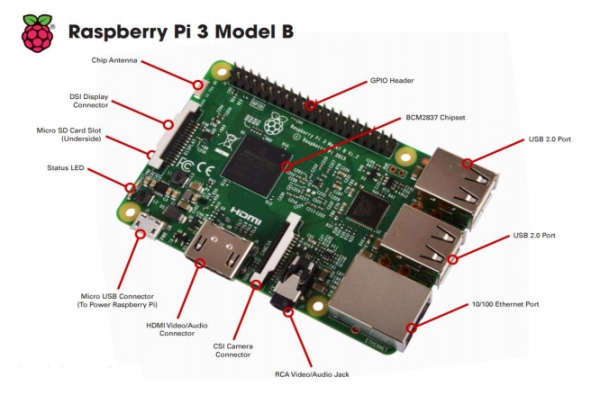
- Processor; Broadcom BCM2837 SoC with a 64 bit processor-1.2GHz quad-core arm
cortex-A53 CPU
- Micro USB Connector; transports the micro USB port voltage and turns it into the 5V
USB, 3.3V, 2.5V and 1.8V core voltages. These are needed for the Ethernet and
processor components of the computer. - General-Purpose Input / Output (GPIO); a 40 generic pin on an integrated circuit. The
pins are connecting the Pi to the outside world and can be programmed to interact in a
number of impressive ways. Inputs do not have to be physical connections; they can
also be sensor or come from another device or computer. - Wi-Fi; 802.11b/n Wi-Fi and Bluetooth 4.1
- CSI Camera Port; a port to connect the Pi with a camera.
- USB Port; 4 channels that are connection ports for peripheral devices such as mouse,
keyboard etc. - Audio/Video; provides connection points with audio out devices such as speakers or
headphones. - Card Socket; Micro SD socket requires a flash card to store the operating system and
files. - Mounting Holes; 4 holes in the corners of the board, used to physically attach the Pi to
something such as a touchscreen. - LED; Used for indicator lights.
- HDMI; a port used to connect the Pi with compatible devices such as HD television with
an HDMI cable for a clearer picture or video streaming. - Ethernet; a port used to connect the Pi with a wire network.
- DSI Display Connector; a port to connect the Pi to a touchscreen.
2.2 Adafruit 2.8” Touch Screen
The chosen screen towards the project is the 2.8-inch touch screen. This screen will be connected
to raspberry pi 3. To start off with the 2.8-inch, the touch screen’s sensitivity with 10 fingers
capacitive touch. The resolution of this screen 320 x 240 pixels which is high. Visually, the 2.8-
inch screen is harder to view from but it is still functional in viewing objects but not as good as
the 7-inch touch screen [8]. This screen requires a minimum of 1.3 watts of electric power in
order to work [8]. The 2.8” requires to be programmed in order to function with the raspberry pi.
The steps below show how the screen is programmed in the raspberry pi 3
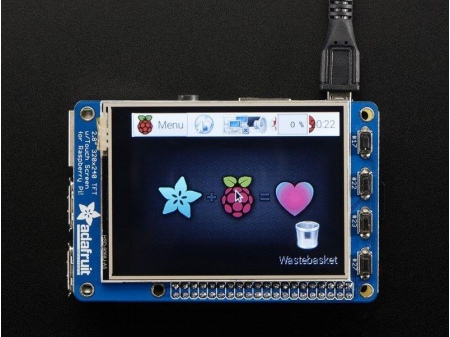
- Run “sudo apt-get update”
- Write this command to distribute the configured files – curl -SLs
- https://apt.adafruit.com/add-pin | sudo bash
- [pi1]device_tree=bcm2708-rpi-b-plus.dtb
- [pi2]device_tree=bcm2709-rpi-2-b.dtb
- [all]
- dtparam=spi=on
- dtparam=i2c1=on
- dtparam=i2c_arm=on
- dtoverlay=pitft28r,rotate=90,speed=32000000,fps=20
- Rotate=90 tells the users to rotate the screen in different degrees, horizontally or vertically. 0 degree is portrait view with USB jacks in the bottom and 90 degrees is landscape with headphone jack in the bottom. You can change the view by changing the variable 90 to 0 and repot the raspberry pi.
- Speed variable shows how fast the sequence of screen moves. Q8 engineering team used 32 MHZ to shows the screen clearer and faster.
- Restart by the command “sudo reboot”
- sudo mv /usr/share/X11/xorg.conf.d/99-fbturbo.conf ~
- export FRAMEBUFFER=/dev/fb1 startx
- After programming the screen, there is some calibration needed to be done for the touch function.
- Run sudo nano /etc/udev/rules.d/95-stampe.rules
- SUBSYSTEM==”input”, ATTRS{name}==”stmpe-ts”, ENV{DEVNAME}==”event“, SYMLINK+=”input/touchscreen”
- Remove and re-install the touch screen with sudo rmmod stmpe_ts; sudo modprobe
- stampe_ts
- Then, Is-I /dev/input/touchscreen and this command will show eventx, x is a number that
- will be changed since we have keyboards/mice/usb devices that will be connected.
- Run evtest by sudo evtest/dev/input/touchscreen then press on the touchscreen to restart
2.3 Raspberry pi Case
Q8 engineering team with the help from Engineering Design I student have designed a
simple case that gathered all the hardware part together. The idea behind this case is to
prevent the raspberry pi from breaking down and act at the same as a stand for the kids. First
step in our design was gathering the dimensions for all parts and use solid works to 3D print
the case. The figures below show the dimensions of all parts and the final view
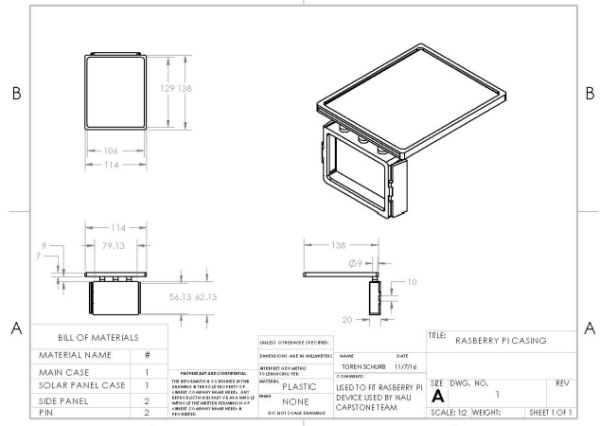
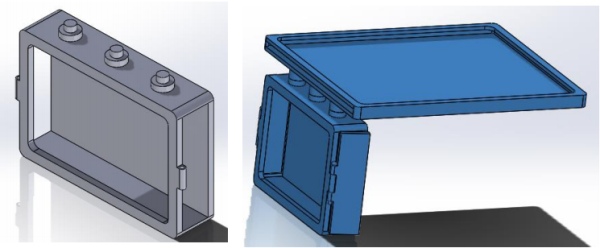
2.4 Solar Panel Powering
Most developing countries in world are located in Africa [10]. Many African countries are
exposed to a lot of sunlight because of its location near the equator [11]. Rural areas, especially
dry areas, gives solar power the potential to distribute energy through the access of sunlight [10].
Q8 engineering team have designed a connection that would power the raspberry pi through high
efficiency monocrystalline cell [12]. The table below shows the material and their specifications
Table 2.4: Solar Power Specifications

Source: Design Applications for Girls on Raspberry Pi Platform

